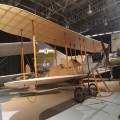
Fairey Swordfish | |
|---|---|
| Country | UK |
| Role | Torpedo-bomber |
| First flight | 17 April 1934 |
| Built | 2391 |
The Fairey Swordfish was a biplane torpedo bomber designed by the Fairey Aviation Company. Originating in the early 1930s, the Swordfish, nicknamed “Stringbag”, was operated by the Fleet Air Arm of the Royal Navy, in addition to having been equipped by the Royal Air Force (RAF) alongside multiple overseas operators, including the Royal Canadian Air Force (RCAF) and the Royal Netherlands Navy. It was initially operated primarily as a fleet attack aircraft. During its later years, the Swordfish became increasingly used as an anti-submarine and training platform. The type was in frontline service throughout the Second World War, but it was already considered obsolete at the outbreak of the conflict in 1939.
Source: Fairey Swordfish on Wikipedia
| Fairey Swordfish Mk III Walk Around | |
|---|---|
| Photographer | Bill Maloney |
| Localisation | Vintage Wings of Canada |
| Photos | 21 |
| Fairey Swordfish Walk Around | |
|---|---|
| Photographer | Dean |
| Localisation | Unknow |
| Photos | 41 |
See also:
The Fairey Swordfish was a medium-sized biplane torpedo bomber and reconnaissance aircraft. The Swordfish employed a metal airframe covered in fabric. It had folding wings as a space-saving measure, which was useful onboard aircraft carriers and battleships. The Swordfish was powered by a single Bristol Pegasus radial engine that gave it a modest speed of around 140 mph. The Swordfish had a crew of three: a pilot, a navigator/torpedo operator, and a rear gunner. The Swordfish could carry a variety of weapons, including a 1,600 lb torpedo, bombs, rockets, or depth charges.
The Swordfish was designed by the Fairey Aviation Company in the early 1930s and entered service with the Royal Navy in 1936. Despite being outdated by the start of World War II, the Swordfish proved to be a reliable and effective weapon that achieved several notable successes against enemy ships, such as the Italian fleet at Taranto and the German battleship Bismarck. The Swordfish was also used for anti-submarine patrols and training missions. The Swordfish remained in service until 1945, having outlived some of its intended replacements. A total of 2,391 Swordfish were built by Fairey and Blackburn Aircraft.
Views : 4143












